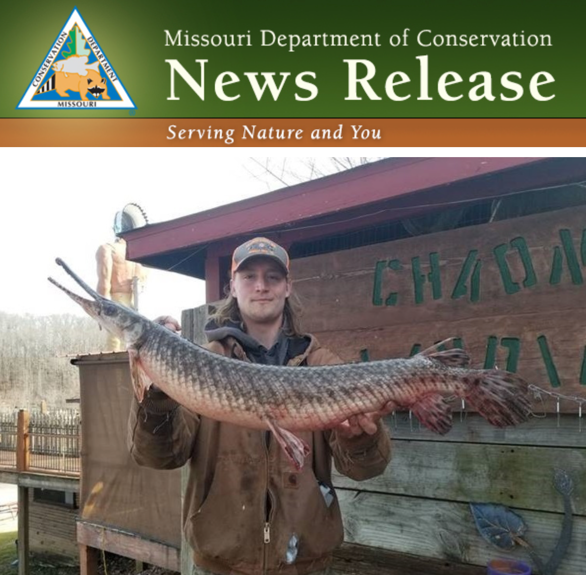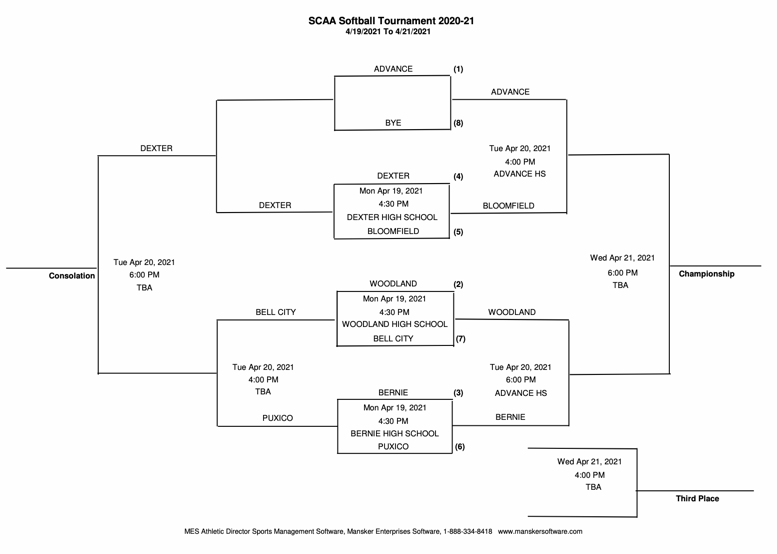
Devlin Rich of Williamsville caught a 10-pound, 9-ounce fish from Wappapello Lake.
Wappapello Lake, MO - The Missouri Department of Conservation (MDC) congratulates Devlin Rich of Williamsville for catching a new state record spotted gar. Rich was fishing with a pole-and-line at Wappapello Lake Feb. 25 when he reeled in the 10-pound, 9-ounce fish. His catch is not only the latest Missouri state record, but it beats the current spotted gar world record of 9-pounds, 12-ounces set back in 1994.
Spotted gar is rather common and widely distributed in the Bootheel lowlands of southeastern Missouri.
“Because of the hard, bony jaws, gars are seldom taken on hook-and-line and are rarely used for food,” noted MDC Fisheries Programs Specialist Andrew Branson. “Special techniques are required to capture them consistently with rod-and-reel, but they do provide a ready target for the bow hunter because they often bask near the surface of the water.”
Gars are generally associated with warm, sluggish backwaters. They frequently rise to the water’s surface, opening and closing their jaws with a loud snap, then sinking below. This behavior allows them to swallow air into their swim bladder, which allows it to function much like a lung. This adaptation helps them survive in still or slow waters with relatively low oxygen levels.
MDC staff verified Rich’s record-breaking catch on a certified scale in Williamsville. This is the second state record caught in 2021.
Missouri state record fish are recognized in two categories: pole-and-line and alternative methods. Alternative methods include: throwlines, limb lines, bank lines, jug lines, spearfishing, snagging, snaring, gigging, grabbing, archery, and atlatl.

Poplar Bluff, MO - The Dexter Bearcats baseball team fell to Poplar Bluff 9-8 on Monday on the final play of the game. The game was tied at eight with the Mules batting in the bottom of the 7th when a single on a 1-1 count scored a run.
Despite the loss, the Bearcats did collect nine hits and captured the lead in the 2nd inning when Kaeden Kennedy drew a walk, scoring a run. They also put up five runs in the 2nd inning. Dexter put the pressure on, lead by walks by Cole Nichols and Camden Riley and a single by Bradyn Crockett.
Poplar Bluff answered back with five runs in the 5th inning. In the 8th inning Dexter evened things up at eight.
#8 Parker Moore started the game for Poplar Bluff. The fireballer lasted one and two-thirds innings, allowing four hits and six runs while striking out three. #7 Jake Valenzuela threw three and 2/3 innings in relief out of the bullpen.
Poplar Bluff (7-11) improved to 4-1 in conference play.
Cole Nichols took the loss for Dexter. The right hander lasted four innings, allowing five hits and seven runs while striking out two.
Dexter had nine hits in the game. Adam Saylors, Peyton Driskill, and Riley Slusher all had multiple hits for the Bearcats. Slusher, Driskill, and Saylors each collected two hits to lead. Kennedy led with two stolen bases, as they ran wild on the base paths with seven stolen bases.
Pitching
L: Cole Nichols
HBP: Cole Nichols 2, Camden Riley 3
WP: Reece Justice
Pitches-Strikes: Reece Justice 16-8, Cole Nichols 82-51, Camden Riley 46-23, Brock Wyman 0-0
Groundouts-Flyouts: Reece Justice 0-0, Cole Nichols 5-3, Camden Riley 0-3, Brock Wyman 0-0
First pitch strikes-Batters faced: Reece Justice 1-3, Cole Nichols 14-22, Camden Riley 6-13, Brock Wyman 0-0
Batting
2B: Peyton Driskill
TB: Bradyn Crockett, Peyton Driskill 3, Josh Kaufman, Cole Nichols, Adam Saylors 2, Riley Slusher 2
RBI: Bradyn Crockett 2, Josh Kaufman, Cole Nichols, Camden Riley
ROE: Josh Kaufman, Kaeden Kennedy
FC: Riley Slusher
HBP: Cole Nichols
SB: Peyton Driskill, Kaeden Kennedy 2, Cole Nichols, Adam Saylors 2, Riley Slusher
Dexter will be back in action on Wednesday, April 21, 2021 at Jackson High School. (Note: this game was rescheduled from Tuesday)

The SCAA Softball Tournament has been postponed for Tuesday, April 20, 2021.
The tournament will resume tomorrow at the times listed on the bracket. The third place and championship games will take place on Thursday.
Wednesday, April 20th - All games will be played at the higher seed.
#1 Advance vs #4 Bloomfield @ 4 p.m.
#2 Woodland vs #3 Bernie @ Advance HS
#7 Bell City vs #6 Puxico @ 4 p.m.

Raiders Advance To the National Tournament Undefeated
Poplar Bluff, MO - As the Three Rivers Lady Raiders sealed their own birth in the Junior College National Finals Tournament this past weekend, Chaylea Mosby, power guard for the team was honored being named the Most Valuable Player for Region 16. Mosby is a 2019 graduate of Dexter High School and the daughter of Angela Mosby.
Ending the season with an undefeated record of 21-0, the Lady Basketball Raiders have been seeded 9th in the National Tournament held at Rip Griffin Center in Lubbock, Texas.
The Raiders (21-0) beat Moberly Area 78-76 in the Region XVI championship game Saturday at the Libla Family Sports Complex
They will now play the number 24 seed Eastern Oklahoma State Mountaineers at noon on Monday, April 19th. The Lady Raiders are one of two remaining undefeated teams in the nation.
Eastern Oklahoma earned its first NJCAA Region 2 Tournament title since 2001 with a 77-70 win over Seminole State College. The Mountaineers finished the season with an overall record of 18-4.
This will be the fourth time in Three Rivers program history that they have qualified for the national tournament. The last one being in 2019.
The Lady Raiders have beaten the 14th ranked Moberly Area team this year. Mobley Greyhounds were able to get an at-large bid to the national tournament so Region 16 will have two teams representing them .
The winner of first round game next Monday will play number eight seed Casper College Thunderbirds at 4 p.m. on Tuesday, April 20th.
All games of the tournament will be livestreamed on the NJCAA Network at njcaa.org/network so tune in and watch Chaylea and the Three Rivers Lady Raiders.


Dexter, MO - Riley Slusher and Ryder Boles were named to the Class 4 Missouri Basketball Coaches Association Academic All-State team.
The award is for individuals who meet the following criteria to qualify: a senior in good standing with the team and possess outstanding moral character, must achieve a score of 27 or above on the ACT, or 1920 or above on the SAT or 185 or higher on the PSAT and have a grade-point average of 3.25 out of a possible 4.0.
Both athletes played for the Dexter High School basketball team.
When asked of Ryder how did this achievement feel, "Feels pretty good," he said with a smile. Riley also nodded that it felt pretty good to get this honor!

